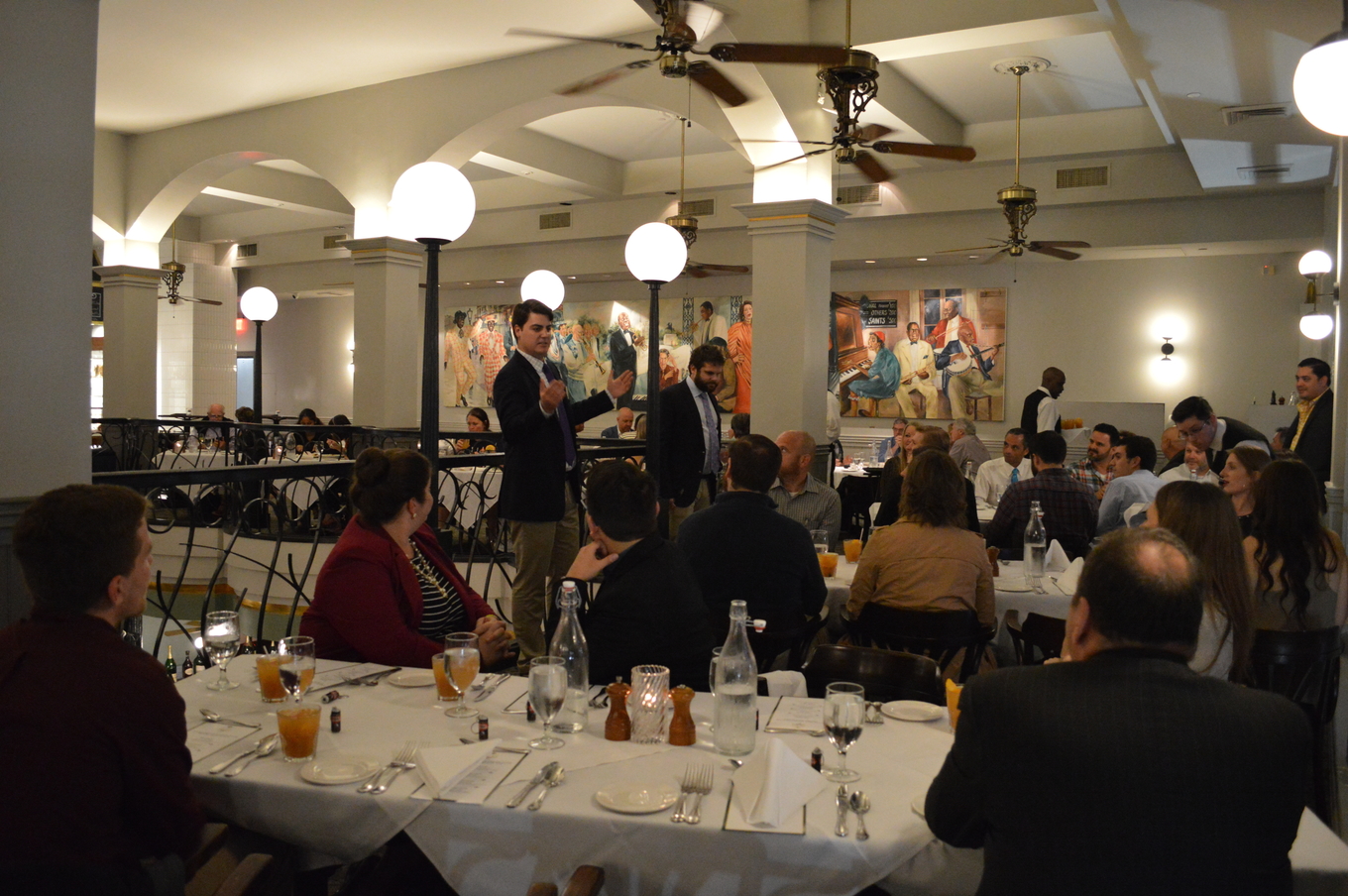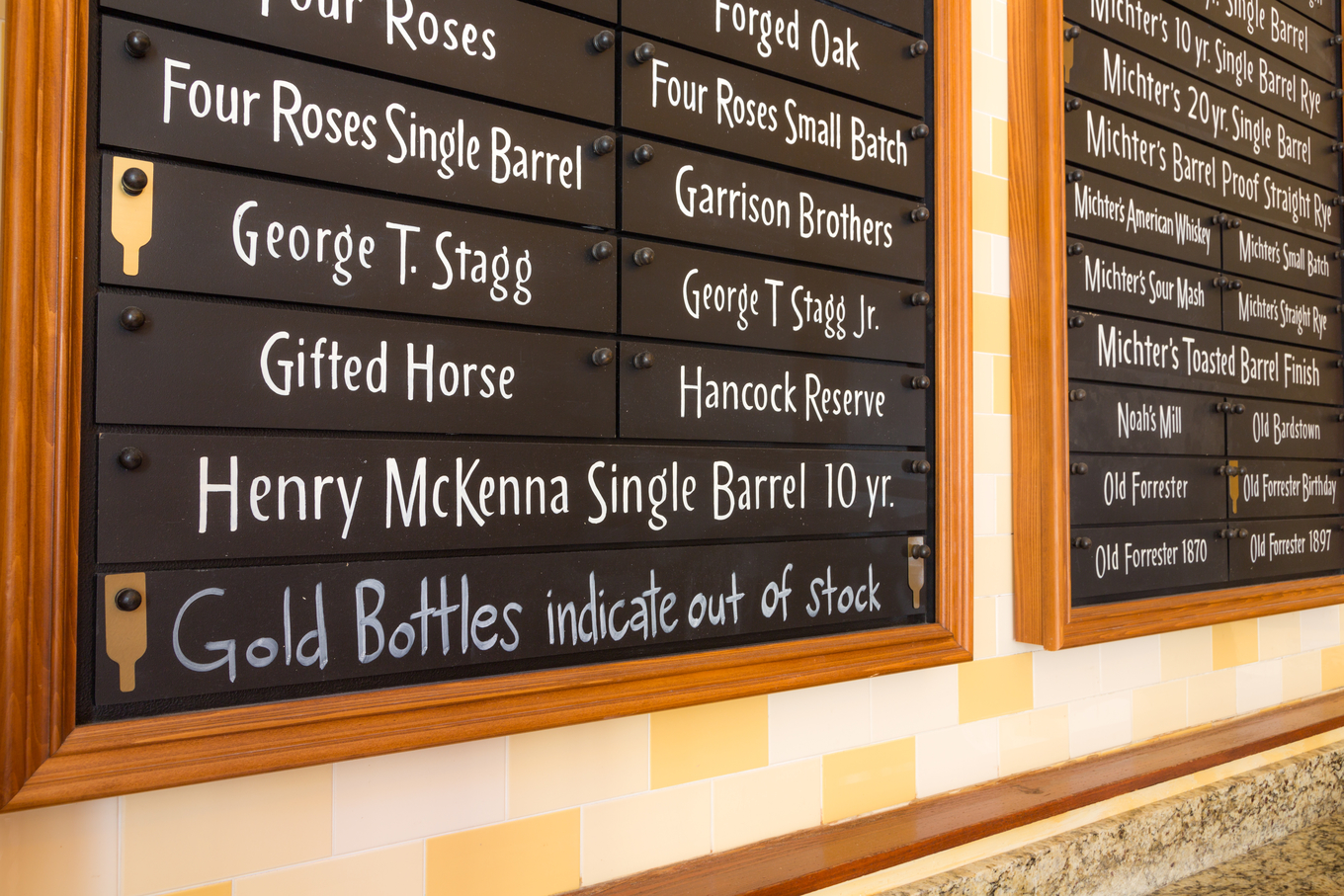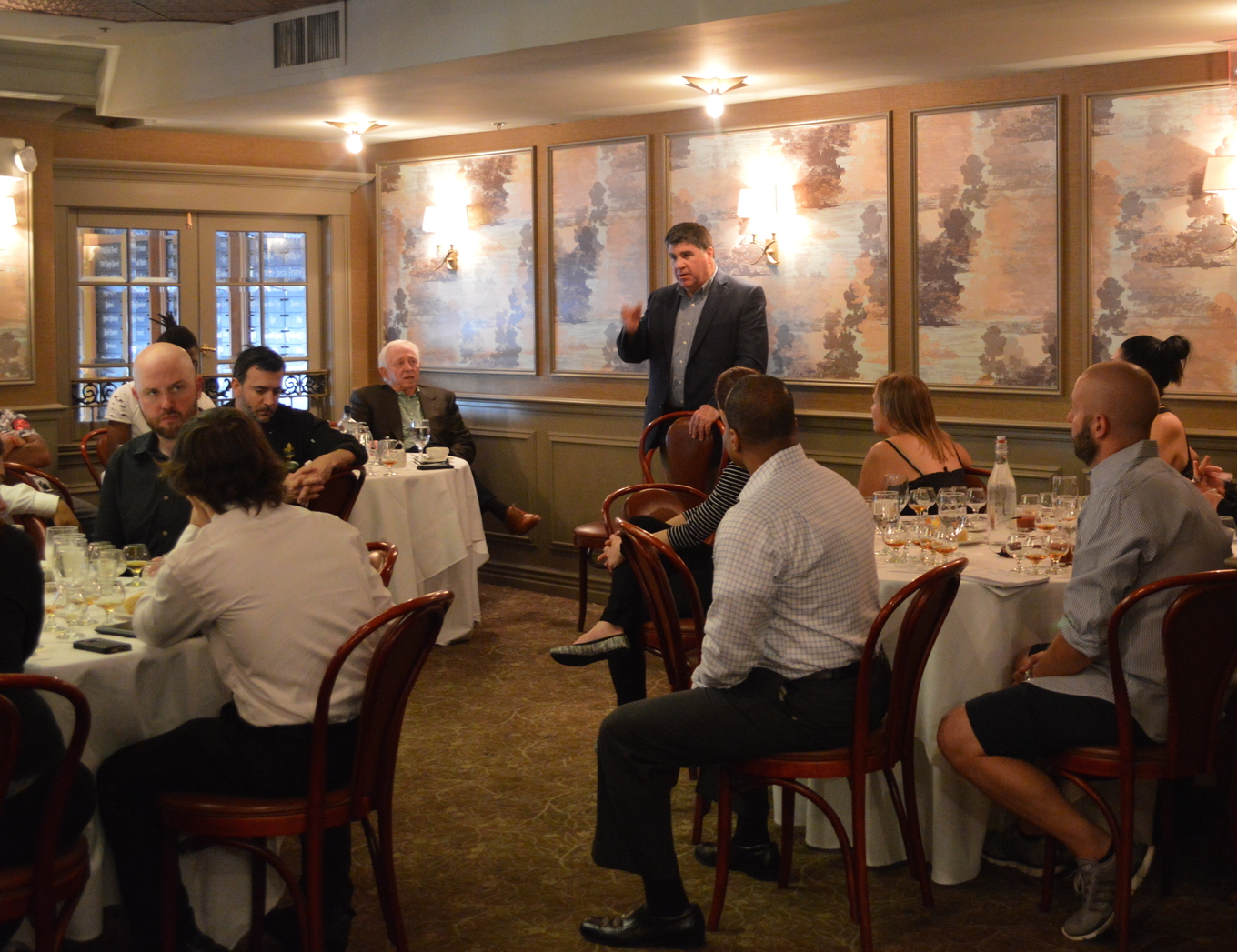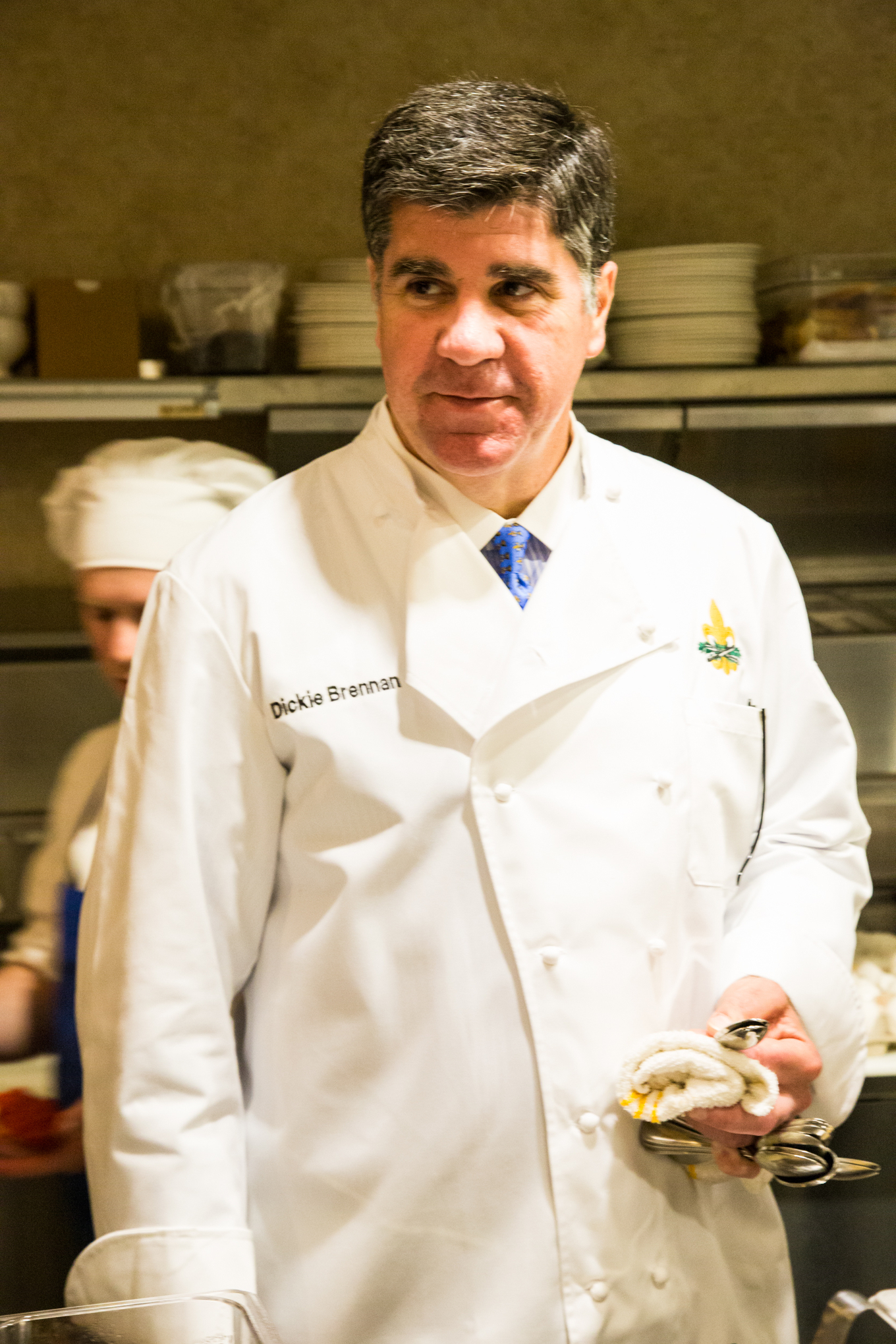Words by Jeff Berry

New Orleans has always been a magnet for cocktail connoisseurs and chroniclers, mixologists and alcohologists. At Beachbum Berry's Latitude 29, my bar-restaurant on Peters Street in the city's French Quarter, I've had the privilege of hosting quite a few of them. Some have even become regulars.
This is the sixth installment of The Peters Street Regulars for Difford's Guide, in which I profile those regulars who are likely to interest you as much as they interest me.

Dickie Brennan
Not everyone born into a family dynasty chooses to claim their birthright. Michael Rockefeller rejected his family's oil billions to live with primitive tribes in New Guinea. Edward VIII abdicated the throne of England to pursue American divorcée Wallis Simpson. But Dickie Brennan - third-generation scion of a New Orleans restaurant empire that began with the 1943 purchase of The Old Absinthe House and now boasts 19 restaurants in four states - has no regrets about following in his dad's footsteps. "I know how lucky I am," he says. "I've had just great experiences with dynamic people. I've lived an incredible life in food and drink. And I've never wanted to venture outside of that."
Dickie loves restaurants the way Edward loved Wallis. Which is convenient, since he runs four of them in the French Quarter alone. At two of these, he's combined his passion for fine dining with a passion for fine spirits.
Since its inception in 2002, the American whiskey collection at Dickie Brennan's Bourbon House has grown to over 200 expressions - the rarest housed in a floor-to-ceiling display case - which the restaurant's New Orleans Bourbon Society decants for members at monthly tastings, dinners pairing each course with bourbon cocktails, and boozy seminars where local aficionados can rub elbows, and bend them, with Kentucky's master distillers.

A few blocks from Bourbon House, Dickie recently began giving rum the same treatment in the Black Duck Bar, upstairs at his Palace Cafe. In its two-year existence, Black Duck has amassed 125 different expressions, which its New Orleans Rum Society explores at distiller meet-and-greets, tastings and dinners patterned after the Bourbon Society's.

Rum Society Dinner
Before he became the French Quarter's baron of brown liquor, Dickie apprenticed at the restaurant that would eventually become his family's flagship - and the incubator of future celebrity chefs Paul Prudhomme and Emeril Lagasse. But when Dickie started at Commander's Palace in 1974, things could easily have gone the other way. Before Dickie's aunt Ella and dad Dick Sr. took command of Commander's that year, it was a 94-year-old Garden District dinosaur serving the same traditional Creole fare as the city's other old-school haunts. But Ella and Dick Sr. bucked the city's staunchly conservative menu conventions and pushed Commander's into the vanguard of the New American Cuisine and Farm To Table movements, then still in their infancy at Chez Panisse in Berkeley and the River Café in Brooklyn.
"I was just there at an incredible place and time," says Dickie, who at age 14 parked cars, checked coats, bussed tables, and eventually landed in the kitchen. "Paul Prudhomme was the first chef I worked for. Luck of the Irish, I guess! To hang around Paul when he was talking about creating a menu for someone, just the way it came out of him - I think probably the most wonderful thing in my life is the mentors I've had. Just people that I got connected with."
Dickie's second boss was equally inspiring. "My freshman year of college," remembers Dickie, "my dad said 'I want you to get out of town and go live in another country and work for somebody,' and I went and worked for Nick Noyes." A Chicago native who went to Mexico in 1955 for a quickie vacation and never left, Noyes owned nine Mexico City restaurants by 1978. One of them was the Mauna Loa, a dome-shaped Polynesian palace with live flamingos in the dining room grotto. The birds were upstaged nightly by a chimpanzee that descended from the ceiling on a rope to a tiny table, where he shook himself a cocktail, drank it between puffs on a cigarette, then disappeared back up the rope. Dickie worked in the Mauna Loa kitchen, but claims he learned more sitting next to Noyes during their hour-long drive to work, when the restaurateur rattled off idea after idea for new ventures.
After graduating from LSU, in 1983 Dickie continued his culinary education in Manhattan under Larry Forgione, who was then making headlines as New York's "godfather of American cuisine." Forgione had just left the River Cafe to launch the storied farm-to-fork restaurant, An American Place. "I got to see someone open a restaurant, and he was just real passionate," says Dickie. "On Friday nights, his mentor would come in and critique what we were doing. It was James Beard. I've got a picture - four or five of us, it was a small restaurant, small crew - Julia Child's in the picture with us."
"After I spent time with them I went overseas," continues Dickie. "I went to the south of France for a couple of months and did stages around the Côte d'Azur. I staged for Alain Ducasse, before he opened his place in Monaco." Dickie followed that with a year in Paris working in six different restaurants, switching kitchens every two months as he hopscotched from such Michelin-starred institutions as Tour d'Argent, Taillevent, and Gerard Besson.
At age 25, armed with formidable training from some of the best boîtes in three countries, it was time for Dickie to rejoin the family business. His cousin Alex needed help running the Brennans' Houston restaurant, "so I put on a coat and tie instead of a chef's hat, and we co-managed. It was 1985, the year the Texas oil industry went bust. All our regulars were taking early retirement and leaving to go wherever they're from. It was a mass exit. I mean, the bumper stickers said 'last man out, turn the lights off.' So we're trying to figure out how to triage a fine-dining restaurant that's 30 years old. We've got to shake it up. Someone said, 'Andy Warhol will do a commercial if you want.'" The resulting 10-second TV spot featured Warhol speaking directly into the camera: "For the most exciting food in Houston, go to Brennan's. Ask for Dick and Alex Brennan and tell them Andy Warhol sent you." The ad didn't exactly work as planned. "We started getting hate mail," says Dickie, "because our clientele were old Houstonians. They were all, 'What are y'all trying to do?' Man, you talk about us catching some flack!"
Business eventually bounced back and in 1990 Dickie bounced back to New Orleans. After another decade spent in the family's restaurants, both in the kitchen and on the floor, in 2002 he was ready to take on the opening of Bourbon House. "Everything we've done in the restaurants has been about American Regional Cuisine, we've always stayed that course - and now we've got this opportunity to put a restaurant on Bourbon street, and what I want to do is create a seafood restaurant." The shellfish dishes followed the American Regional mandate, but what about the bar? For Dickie, it was a no-brainer: "You know, Bourbon House, it's on Bourbon street. So I just wanted to feature bourbon."

Bourbon House wall menu
With his General Manager Mike Cobb and Chief Purchaser Charlie McCall, Dickie plotted his American whiskey revolution. "It was a collaboration," he says. "The mission was: let's go get the greatest collection of bourbons we can, and let's educate everybody. We did some field trips where we sent our bartenders up to Kentucky before we opened, just like we've always done with any of the oyster shuckers that we hired - we put them on a boat and they go out all day with the oyster farmers - so, same philosophy with bourbon. So, there was a lot of dialogue about bourbon, and it occurs to us that people come to wine dinners. Can we, maybe, get our talented young chefs to create a bourbon dinner, and let people come taste bourbons with each course? With that, we asked the bourbon makers to come do what a wine-maker would. Come be the host." The inaugural dinner was hosted by Booker Noe, the legendary master distiller of Jim Beam. "It was right before he passed; his son Fred was with him. We had a good old time with those two guys."

Dickie at bourbon dinner
After successfully luring high-end consumers away from single malt scotch to "single barrel" bourbon, the American whiskey market was evolving and expanding. "It continued to amaze us how many people were bourbon fanatics," says Dickie. "I mean, if we did a bourbon dinner, it was sold out. At one point we invited four master distillers to come down, 'cause it was really working good." Industry icons Elmer T. Lee of Blanton's, Jimmy Russell of Wild Turkey, Jimmy Bedford of Jack Daniel's and Harlen Wheatley of Buffalo Trace gathered for one night at Bourbon House for a reception-style dinner, with food stations for each of the four brands. "I'll never forget when we finished. Everybody cleared out, and I'm sitting there with these four guys, and they're like, 'Man, we've grown up with each other, we know each other, we've been doing this all our lives, we've never done anything like this.' And we realized we were on to something by getting them out, and getting them in front of the people who love food and want to drink great spirits."
After several more years of doing just that, Kentucky's governor made Bourbon House an honorary stop on the Kentucky Bourbon Trail, even though the restaurant was over 700 miles and four states away from the actual trail. "They made me a Kentucky Colonel, all this crazy stuff," laughs Dickie, who in 2015 decided to see if lightning could strike twice with a different spirit at another of his restaurants. "I thought with rum, there was such a local connection - with the Caribbean, where rum originated, and with Louisiana sugar cane, which some people were starting to make New Orleans rum with." The result was the Black Duck Bar. "Our Beverage Director, Barry Himel, started collecting rums before we opened up, and so we opened with a nice little collection."

Black Duck Bar
Their Rum Society is now doing for local rum what Bourbon House does for American whiskey, with an added emphasis on pairing spirits with food. "That was a big part of it, that we would have food in the bar to pair with the rums," says Dickie. Although Black Duck specializes in charcuterie and small plates, Dickie's decades of kitchen experience, coupled with his more recent experiments with bourbon and rum, has made him an advocate of serving spirits and cocktails throughout a multi-course meal.
"First of all," he argues, "spirits have always been part of food recipes. If we didn't flame a little rum in Bananas Foster, it just wouldn't be the same thing. Or whiskey in a Crème Anglaise. Food and spirits just naturally marry really well. It's chemistry. We've had no push-back that we're trying to introduce spirits throughout a meal, as opposed to switching to wine. I think a lot of people get into the rhythm of what they're used to, and sticking with the norm. But wine doesn't work with everything. Asian food, pizza - certainly a cocktail can end up being more of a companion to a dish than wine. The more we do these dinners, the more I think it's not a fad. I think it's going to continue to evolve in the marketplace, because it works. More people are going to say, 'Well, I'm having this dish, this egg-roll, and I think I want this kind of cocktail to go with it.'"
After bourbon and rum, is there another spirit on Dickie's docket? He answers with unbridled enthusiasm: "Irish whiskey. I'm kinda softening up on just being American." At Dickie Brennan's Steakhouse, another of his French Quarter restaurants, the bar now offers 20 different brands of Irish whiskey, with more on the way. "We need to do a better job of people knowing it's there," says Dickie. He credits Sean Muldoon, owner of The Dead Rabbit Grocery And Grog in New York, for opening his eyes to the category. "Because he's Irish, we connected. We sat down and we drank way too much Irish whiskey the first time we met at the Dead Rabbit. I'm like, 'I thought there was just Jameson and Paddy.' And Sean was like, 'Ohhhhh nooooo.'"
More Peters Street Regulars
#1 The Rum Life Of Stephen Remsberg
#2 Wayne Curtis: The Accidental Authority
#3 Paul Gustings: The Badass Of Broussard's
#4 A Drinking Club With A Motorcycle Problem
#5 Abigail Gullo: The Chanteuse Of Vermouth







Join the Discussion
... comment(s) for Dickie Brennan: Putting The Bourbon In Bourbon Street
You must log in to your account to make a comment.